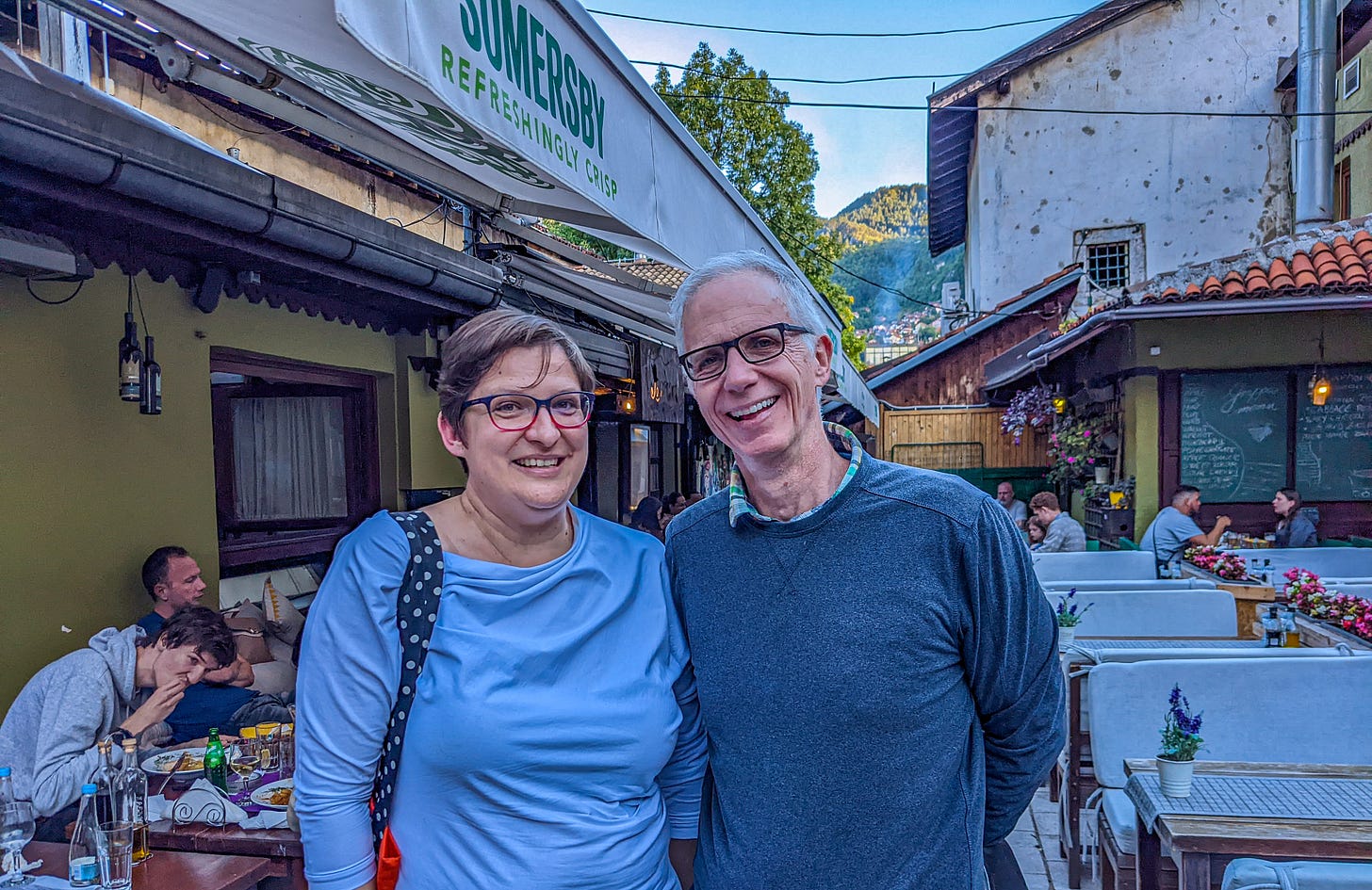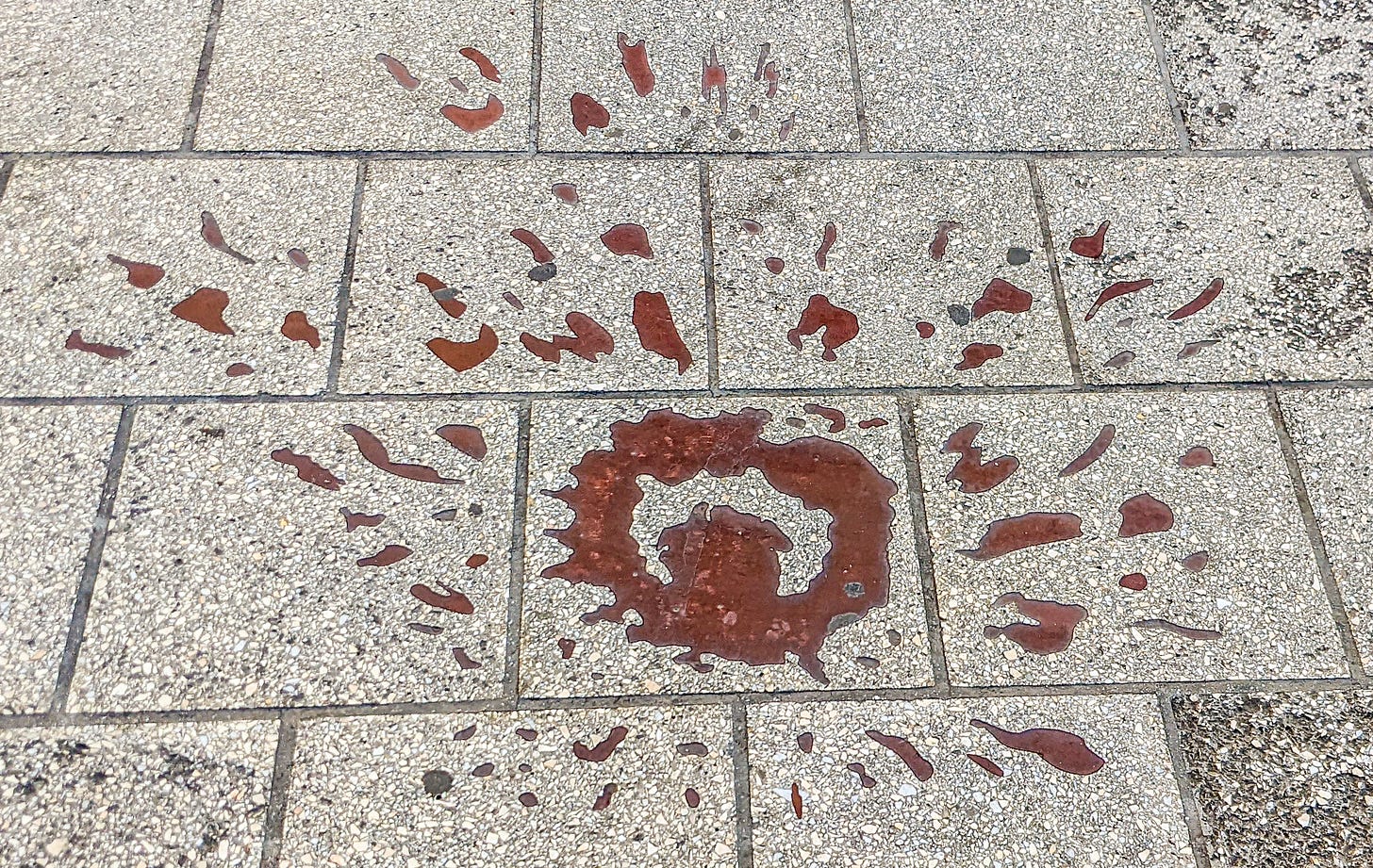Sarajevo is a Great Place to Visit (But a Lot of Locals Don't Want to Live There)
Life in the capital of Bosnia and Herzegovina was great for us. But things are less good for the locals.
For an audio version of this article, go here.
Before I share my thoughts about Sarajevo, the capital of Bosnia and Herzegovina, let’s start with a joke.
A woman dies, and St. Peter welcomes her into heaven. But honestly, heaven seems a little boring — clouds and harps and angels with wings. So she says to St. Peter, “Is there any chance I could see what hell is like?”
“Sure,” says St. Peter. “You can visit for seventy-two hours.”
So the woman goes to hell for three days, and she’s shocked by how much fun it is: great music, fantastic food, lots of fascinating people, and endless things to do and see.

After three days, the woman returns to heaven and says to St. Peter, “I’m surprised to hear myself say this, but hell seems a lot more fun than heaven. Is there any chance I could stay there for a bit?”
St. Peter says, “You can live in hell if you want, but once you make that choice, there’s no going back. You’ll have to spend all of eternity there.”
The woman thinks it over and finally says, “Okay, yes, then I choose to spend eternity in hell.”
The ground immediately opens up and she plunges downward. But instead of the great food and music and people from before, she’s surrounded by fiery pits of lava and demons tormenting people in all sorts of terrible ways.
“I don’t understand!” she cries as she’s swallowed by the lava. “This isn’t at all what it was like before!”
St. Peter smiles sadly and says, “That’s because before you were there as a tourist. Now you’re there as a local.”
Our Airbnb host in Sarajevo told Brent and me this joke one evening last month, after she and her husband invited us upstairs for Bosnian coffee. I had just told her how much I was loving their city.
We all laughed at the punchline, and I appreciated the reminder that our experience of a place is usually very different from that of the locals.
But that dark joke proved especially prescient for this particular city.
My initial impressions of Sarajevo were a lot like that woman on her first trip to hell.
The city was beautiful, and I loved it.
It’s small, home to only four hundred thousand people, and situated in a mountain valley. In the eastern end of the valley, where we lived, the walls of the valley are surprisingly steep, and the red-roofed houses climb directly up into the green trees above. Muslim cemeteries climb the hillsides too, their white headstones gleaming like pearls embroidered in a cloth of green.
Just down the hill from our neighborhood of Vratnik is Baščaršija, the “old town” where, in 1461, the Ottoman Empire founded a marketplace that is still the heart and soul of Sarajevo. I loved wandering the narrow alleys, finding hidden plazas, watching locals and tourists alike sample the ćevapi, drink Bosnian coffee, and endlessly puff away on their hookahs.
Brent and I never got tired of it — not Baščaršija, nor the surrounding mountains, which we hiked in almost all directions.
It seemed like, well, heaven.
At the same time, I was also learning a bit about the brutal Bosnian War, which took place back in the 90s, and included the Siege of Sarajevo — which, at 1425 days, is one of the longest in the history of modern warfare. More than 14,000 people died, including over 1500 children.
One day I met a new local friend, Esad, for drinks. He was in his late twenties, wore glasses, and had a decidedly intellectual air. I asked him if he was worried if neighboring Serbia might eventually decide to invade again.
“No,” he said. “Bosnia is a shithole. Why would one shithole country ever invade another shithole country?”
I knew Bosnia had problems, but I was shocked to hear him refer to his own country so disparagingly. I gently told him that.
Esad laughed. “You just don’t know. Things are terrible here. Last year my mother got sick with Covid, so we took her to the hospital. But it was a huge mistake because our healthcare system is so bad. I think she might be alive today if we had just kept her at home.”
I knew Bosnia’s health care system was bad — one of the worst in Europe. But hearing Esad say it so boldly shocked me again.
Still, I thought, things couldn’t be that bad. The people looked happy enough.
But Esad’s words made me see the evidence of the war with different eyes. It’s all around the city, in ruined buildings that have yet to be rebuilt, and in the bullet holes that still pockmark so many walls.
A lot of the people who seemed so happy at first glanced probably dodged some of those bullets. And lost loved ones who weren’t so lucky.
Esad was just the first to tell me how bad things truly are in Bosnia.
For a rafting trip in nearby Konjic, I was picked up one morning by Izmir, a stocky young man in his twenties. He was broad-shouldered and tough looking, but surprisingly soft-spoken.
During the car ride, he told me how he was working two jobs in order to send his younger sister to university. Two or three times a day he made the 60 kilometer trip from Konjic to Sarajevo to fetch fruits and vegetables to sell at his family’s small stand. He also ferried tourists like me to earn extra cash.
The farther we drove, the more frank he was.
“It’s terrible here, and it will never get better,” he told me. “Even if you get a job, the pay is terrible. Everyone young is going to Austria and Germany, and soon Bosnia will be nothing but a country of old men and women.”
Izmir didn’t seem angry about the situation, just resigned. Somehow this seemed worse to me.
He’s not wrong either. The poor economic conditions have resulted in a terrible brain drain. The unemployment rate is in the mid-thirties, spiking to over fifty percent for young people. The best jobs are generally government jobs — usually only available to those with the right connections.
In fact, Bosnia is ranked the third most corrupt nation in all of Europe — “on the verge of complete chaos,” according to Srdjan Blagovcanin, a corruption watchdog who says the country’s democratic institutions verge on complete collapse.
Half of young Bosnians want to leave, with between 50,000 and 55,000 people doing so every year. More than two million Bosnians already permanently live outside of the country, and its official population — 3,378,000 — has dropped by more than a million people since 1991. (Another local friend told me the official count purposefully overcounts the actual population — not that the government would be capable of conducting a proper census anyway.)
Another local friend, Samra, a well-educated woman in her forties, told me that every day it was getting harder to find reasons for her husband, herself, and their two daughters to stay in a country where the future feels so bleak.

The most optimistic person I met was Nadir, a bright, hard-working young man at the coworking space I used. I asked him if he was hopeful about the future, and he said, “Not anytime soon. But once the older generation dies out, then yes. So maybe twenty years from now, things will start to get better. But many of my friends are planning on leaving.”
The longer I stayed in Sarajevo — and the more I learned — the harder it was to see it through the eyes of a happy-go-lucky tourist.
Is this why the hookah bars in Baščaršija were so full of young men and women puffing away? Because the city has too many young people with nothing much else to do?
Brent and I continued doing the tourist attractions, but I was increasingly disturbed how many had to do with the war:
The Museum Of Crimes Against Humanity And Genocide.
The Tunnel of Hope Museum, which includes the tunnel used to sneak food and arms into the besieged city.
The War Childhood Museum.
The Memorial of the Murdered Children of Besieged Sarajevo 1992-1995.
Then there are all the war tours and infamous sites around the city:
Markale market, where more than sixty people died in one single mortar attack.
Sniper Alley, where pedestrians risked their lives trying to cross from one side of the city to the other.
And more than two hundred “Sarajevo Roses,” which are red “flowers” inlaid in the sidewalks commemorating spots where at least three people were killed.
You can even take a tour to see the haunting Olympic venues destroyed during the war.
Not surprisingly, Bosnians are incredibly pessimistic, with almost 70% saying the country is headed in the wrong direction. Countless people suffer from PTSD from the war. One person told me one-third of the city is on anti-depressants.
And if corruption, chronic unemployment, terrible health care, and psychological trauma isn’t enough, Bosnia still suffers from ongoing ethnic tensions.
Remember the joke I told at the beginning of this article?
After living in Bosnia and Herzegovina for six weeks, and meeting more and more Sarajevans, I really did start seeing things with less of the eyes of a tourist. And I saw that for locals, it really is a kind of hell.
But the joke doesn’t seem so funny now, does it?
Michael Jensen is a novelist and editor. For more about Michael, visit him at MichaelJensen.com.








Posts like these are exactly what is wonderful about this newsletter. If you two were just to swing into a city, chronicle your week or two as tourists, and move on, that'd be one thing. But the value in staying for long periods as nomads, you get so much deeper insight in a place and its people!
Wow. Thank you for this post. Definitely not light, happy reading, but it’s important to know what the other side of the coin looks like.